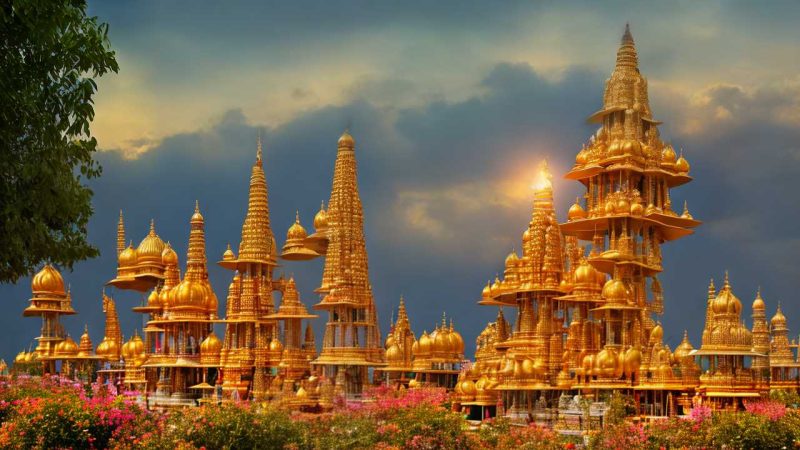The Global Spread of Hindu Worship Spaces

In today’s world, people travel and move around more than ever. This has led to the spread of Hindu places of worship far beyond India. You can now find Hindu temples all over the world. These temples range from large, impressive buildings that are reminiscent of ancient designs to simple rooms in the middle of big cities. They are important spaces for Hindus living away from their home countries and also help introduce Hindu culture to other people.
As Hindu temples pop up in different countries, we can see how the religion changes in new environments. They play a big part in keeping cultural traditions alive for people living abroad. These temples also affect the local religious communities where they are built. When we look at how many Hindu temples there are around the world, it’s clear that they do more than just provide a place for worship. They help people from different backgrounds come together and learn from each other.
However, these temples face challenges as the world changes. They may have to adapt to new situations and different cultures. This shows us that the influence of Hindu worship places is significant. They are not just about religion but also about bringing people together and sharing cultures.
Tracing the Roots Abroad
Hindu communities have spread all over the world, and as they have, they’ve created special places to practice their faith. These are more than just temples; they are centers where Hindu culture thrives, helping to keep their traditions alive in new places.
When you look closely, you’ll notice that these temples mix traditional Indian designs with styles from their new surroundings. This shows how Hinduism can change and fit in with different cultures. These temples are important because they help people from the Hindu diaspora keep their cultural identity and religious practices alive, even as they become part of a wider global community. They show that culture and faith can stay strong, no matter where people are.
For example, a temple in London might have the classic Indian dome, but also use British stones in its construction. This isn’t just about looking nice; it’s about creating a familiar space for worship that also respects the new setting.
Architectural Adaptations Overseas
Hindu temples built outside of India often mix local styles with traditional Indian designs. This combination is not just for looks but also to make sure the temples work well with the weather, available building materials, and local construction rules.
For example, while these temples might still have the classic pointed roofs or towers known as shikhara or vimana, they might be built with materials more common in the area, like concrete and steel instead of stone and marble.
Inside, these temples are set up according to ancient Indian design principles called Vastu Shastra. However, they are also designed to hold more people than many temples in India, as they often serve larger communities abroad. These changes show how the tradition of building Hindu temples is strong and flexible. It keeps the important aspects of religious design and symbolism but also adapts to new places and needs.
Let’s take the example of a Hindu temple in Canada, where heavy snow is common. The temple might have a steeper roof to prevent snow accumulation, which is different from a temple in India. By making these smart changes, the temple stays true to its roots while fitting into its new environment. This approach shows respect for tradition and smart planning for a temple’s new home.
Community and Identity Preservation
In places where people from different cultures live together, Hindu temples outside of India are very important for keeping the culture and community together for those who live far from their homeland. These temples are like centers where Hindu people meet to do their religious activities, celebrate special days, and learn about their culture. They organize different activities that help people feel they belong and teach the younger ones about their heritage.
These temples also help people who have just moved to a new country by giving them support and help. When a new family from India moves to a city in the United States, for example, they might feel lost at first. A local Hindu temple can become a welcoming place for them. They can meet others who have been through similar experiences and find guidance on how to adjust to their new life.
During Diwali, the temple might hold a big celebration, which is not just fun but also a way for everyone to remember and share their traditions. In writing this, I’ve tried to be clear and friendly, like I’m talking to someone directly. My goal is to explain things in a way that’s easy to understand, with details that bring the topic to life.
Interfaith Engagement and Influence
Hindu places where people worship, like temples, are important for bringing different religions together. They help people from various backgrounds understand and respect each other. These temples aren’t just in India; they’re all over the world, acting as spots where different cultures and religions can meet and learn from each other. The way these temples are built often takes in local styles, which shows how different cultures can influence each other.
For example, when non-Hindu people join in Hindu celebrations like Diwali or Holi, it helps everyone see what they have in common, like enjoying festivals and being with family. This is one way Hindu temples help make communities more open to different ways of thinking and believing. By welcoming everyone, they make it easier for people of different religions to get along and understand one another better.
This makes the world’s spiritual life more diverse and rich.
Future Trajectories of Hindu Spaces
Exploring the potential evolution of global Hindu worship spaces, it becomes clear that these religious centers might continue to adapt to the changing cultural landscapes and technological advancements of societies around the world.
As the Hindu diaspora grows and diversifies, worship spaces may increasingly reflect a blend of traditional and host-country architectural and cultural elements.
Technological integration might also enhance religious practices, such as virtual reality for immersive experiences of rituals or distant holy sites.
Additionally, the rise of environmental consciousness could lead to eco-friendly temple designs with sustainable practices.
Analytically, the trajectory seems to point towards a future where Hindu worship spaces are both globally interconnected and locally resonant, serving as dynamic hubs for cultural exchange, spiritual innovation, and community cohesion.
Conclusion
The spread of Hindu worship places around the world shows how people from the Hindu community keep their religious practices alive even when they live far from their original home. These places are more than just buildings; they bring people together, help them hold onto their cultural identity, and encourage conversations between different religions.
As these temples blend into new areas, they can change the way local buildings look and influence the customs there. This shows how the Hindu community and the diverse cultures they live among are learning from each other.
For example, in cities like London or Toronto, you might see a Hindu temple with traditional Indian designs next to modern buildings. This mix of styles can inspire local architects and artists to include these elements in their work. It’s also common for these temples to host festivals where everyone, not just Hindus, is invited. This helps people from other backgrounds learn about and appreciate Hindu traditions.
The temples, therefore, are important places for making friends, keeping traditions alive, and sharing cultures.






